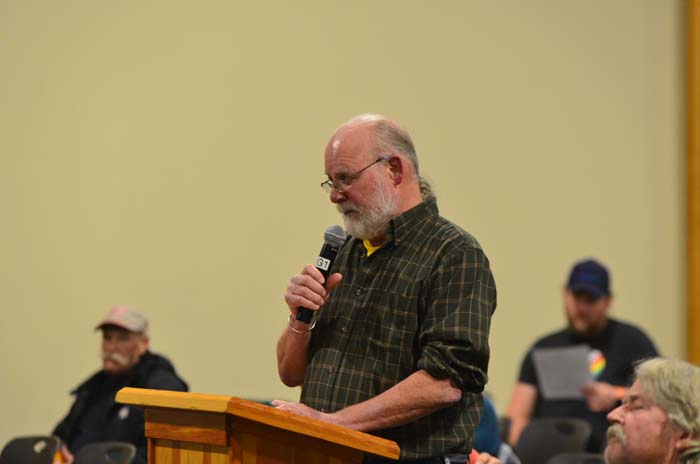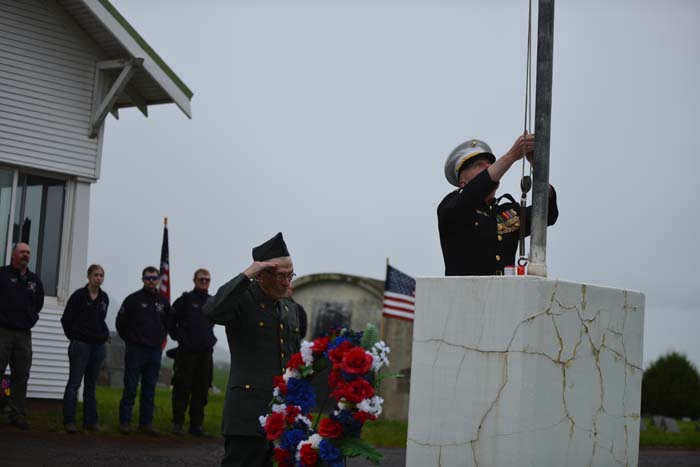Oregon PUC approves Idaho Power’s certificate of public convenience and necessity application for B2H project
Published 7:00 am Friday, July 7, 2023

- Jim Kreider, co-chair of the Union County-based Stop B2H Coalition, addresses representatives of the Oregon Public Utility Commission at a hearing on Idaho Power's petition for a certificate of public convenience and necessity for the Boardman to Hemingway transmission line on Wednesday, Nov. 16, 2022, at Eastern Oregon University, La Grande..
SALEM — The Oregon Public Utility Commission last month granted approval for Idaho Power’s application for a certificate of public convenience and necessity for its Boardman to Hemingway project.
The Thursday, June 29, decision means the Boise-based utility’s project is formally recognized as serving the public interest, and it is projected to begin by the end of the year — though the La Grande-based Stop B2H Coalition is considering appealing the decision to the Oregon Supreme Court.
Megan Decker, PUC chair, in a press release expressed appreciation for the involvement of individuals and groups who voiced concerns about the potential negative impacts of the B2H project on their land.
“The time and effort to voice concerns helped the commissioners take the hard look at Idaho Power’s proposal that it deserved,” she said.
The approval allows Idaho Power to proceed with its plans to construct a 300-mile, 500-kilovolt transmission line that would cross five Oregon counties, including Union County. It would connect the proposed Longhorn Substation east of Boardman to Idaho Power’s existing Hemingway Substation in Owyhee County, Idaho. The transmission line will be jointly owned by Idaho Power and PacifiCorp, with the Bonneville Power Administration contracting to use the line to serve customers in Southeastern Idaho.
The issuance of the certificate signifies that the transmission line is considered a public use and necessary for public convenience, meeting the requirements for condemnation of private property. Idaho Power can now initiate condemnation proceedings in court to secure land rights along the path of the transmission line.
The court will determine the compensation to be provided to the affected landowners.
In evaluating the CPCN application, the PUC assessed whether the transmission line met the criteria of being necessary, safe, practicable and justified in the public interest, according to the release. The commission also considered information and input from affected landowners, interest groups, utilities and PUC staff during the nine-month proceeding.
Decker emphasized the commission’s commitment to conducting thorough evaluations of CPCN applications and ensuring a careful balance of public and private benefits and costs.
Factors considered by the PUC in reaching the conclusion the B2H project is in the public interest included the availability of feasible alternatives, the benefits and costs to customers of Idaho Power and other electric utilities, the value of improved regional electricity grid connections, Idaho Power’s ability to safely operate the transmission line, environmental justice issues and the growing need for transmission to deliver electricity from clean energy resources.
The B2H transmission line is expected to enable Idaho Power, PacifiCorp and BPA to meet the increasing energy demands of their customers while facilitating the delivery of electricity from clean energy sources, according to the Oregon Public Utility Commission announcement.
The state’s Energy Facility Siting Council last fall granted Idaho Power a site certificate that authorizes construction of the line. The state Supreme Court March 9 upheld the council’s decision.
Supporters of the project say the transmission line would provide a crucial link to move energy, much of it from hydroelectric, wind and other clean sources, between the Pacific Northwest, where energy use peaks in the winter, and the Intermountain West, where energy use peaks in the summer.
However, critics argue that the B2H transmission line’s route is ill-advised, and brings up multiple issues, including dissatisfied landowners, underestimated costs and environmental concerns.
Jim Kreider, co-chair of the Stop B2H Coalition, said he felt “deep disappointment” when hearing the ruling of the contested case.
“The landowners are still having their land surveyed to find out what’s on it, and then the mitigation plan is drawn up from that,” he said. “We’re concerned that a person’s land has been condemned and nobody really knows what’s on it all yet … but meanwhile, they’re going to take the person’s land, before they know that.”
Though the certificate gives Idaho Power the right to initiate condemnation proceedings, Sven Berg, a communications specialist for Idaho Power, said this is not the ideal route of action.
“We really, really, really want to avoid eminent domain proceedings,” he said. “We very much want to come to mutual agreements with every landowner. And in fact, even if we were to initiate eminent domain proceedings, we would continue to negotiate with landowners. It’s just a much better way to do business than through the courts, we think.”
With pre-construction activities such as final design, cultural and biological surveys, Berg said they expect to break ground by the end of the year and hopes the line will be constructed and energized by 2026.
Kreider said he will follow up on the mitigation plans for B2H, and will be “bird-dogging” the several amendments made by Idaho Power, which includes adding approximately 1,000 acres and 45 miles of road that the Oregon Department of Energy approved. A public comment period for this amendment will begin on July 14 and end July 18 and will have public hearings in Baker City and Pendleton, according to an ODOE public notice.
Kreider said Stop B2H is evaluating bringing the PUC decision to the Oregon Supreme Court — even though they tried that with ODOE’s decision and weren’t successful.
He said “I’m not thinking we’re up for another battle like that,” but is assessing their options.
Berg said that 17 years of Idaho Power working on fine-tuning the details of the project, listening to critics and being open to feedback is what helped earn them the certificate of public convenience and necessity.
Though Kreider said many landowners along the planned transmission line spoke against its construction at the contested trial, Berg said Idaho Power has some easements from landowners currently. He declined to identify the private landowners in question.
“We obviously didn’t agree on certain aspects of this,” Berg said of Stop B2H. “But we are certainly open to hear their input going forward.”





